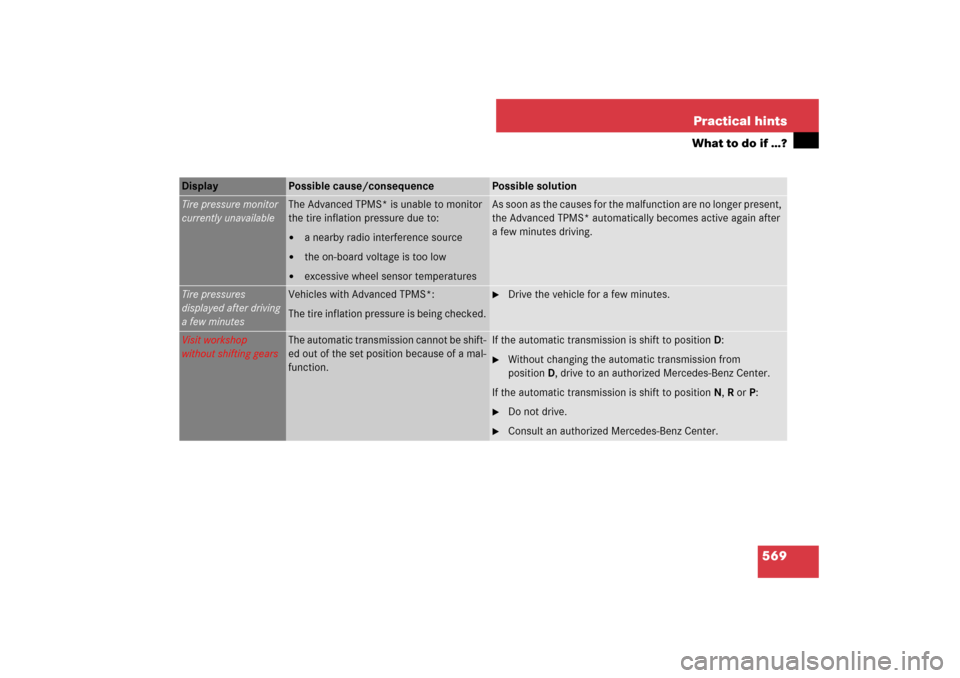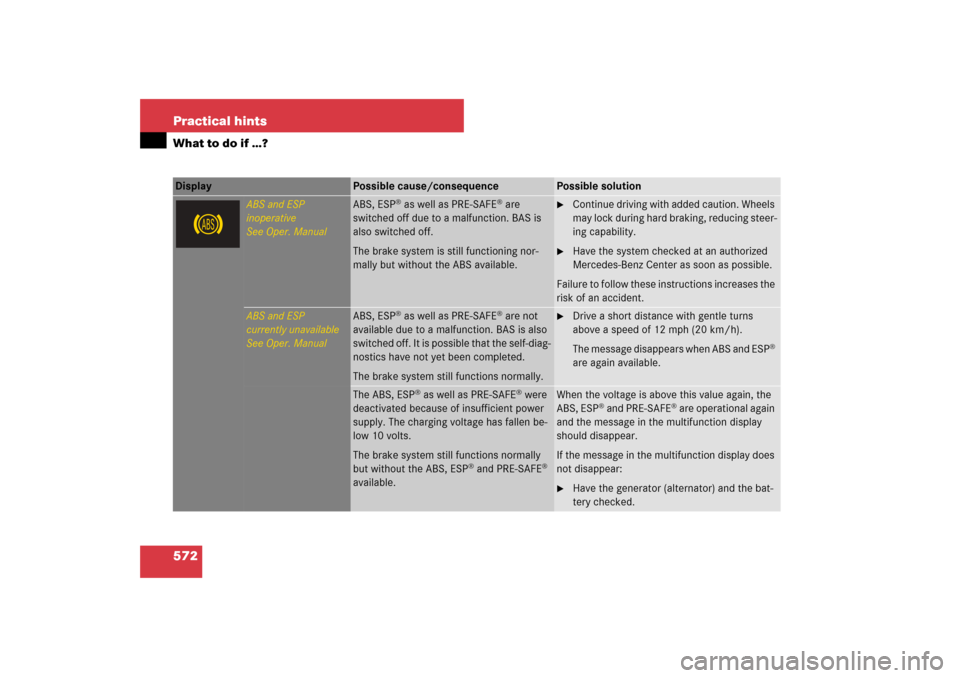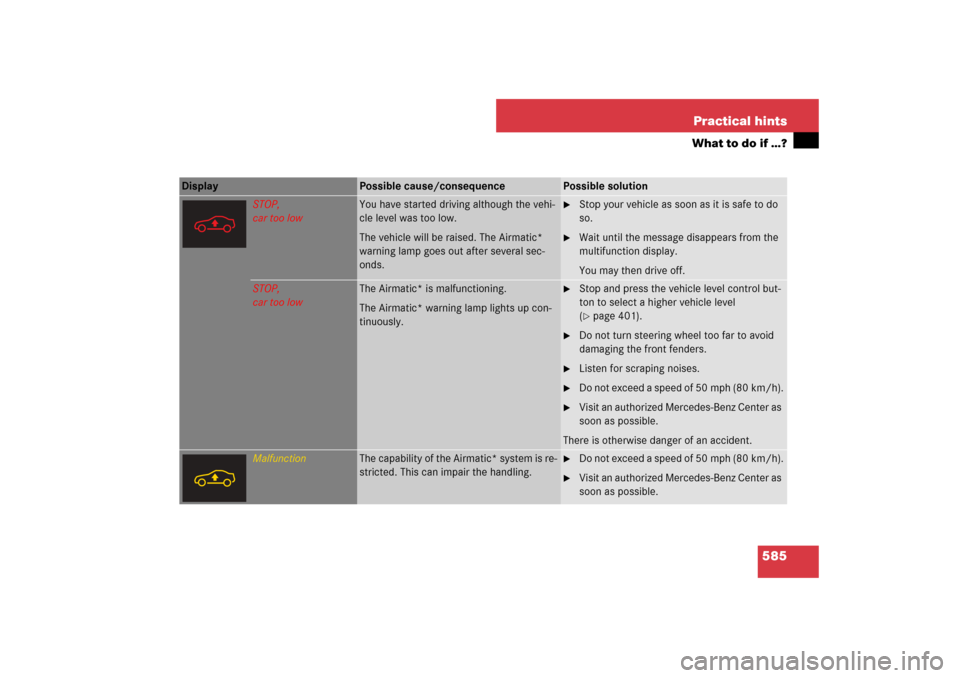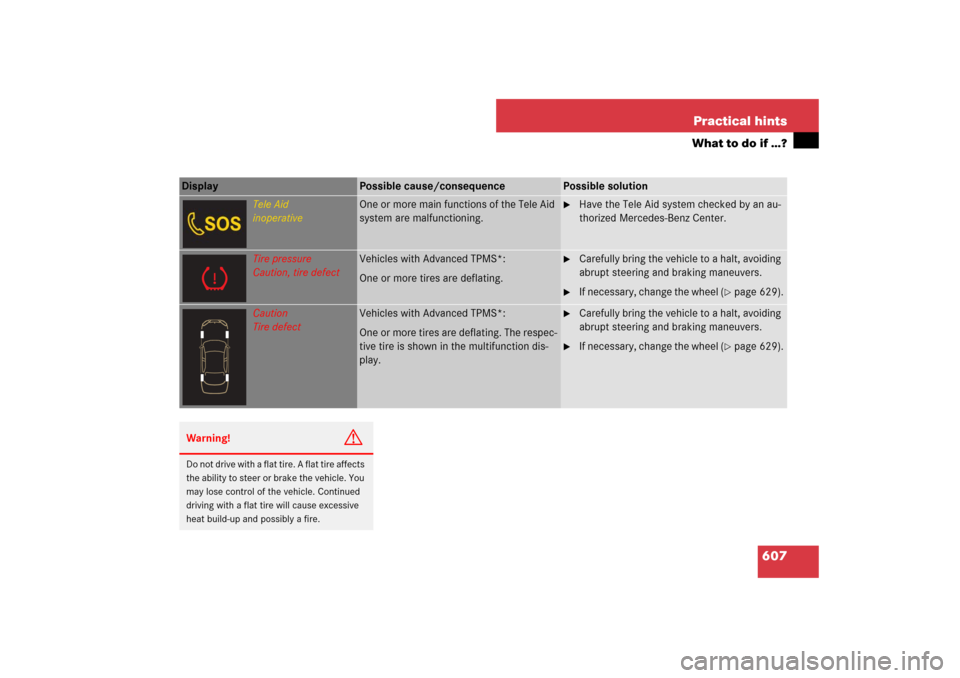Page 569 of 705

568 Practical hintsWhat to do if …?Display
Possible cause/consequence
Possible solution
Tire pressure
Check tires
The pressure has fallen significantly in one
or more tires.
�
Carefully bring the vehicle to a halt, avoiding abrupt steering
and braking maneuvers. Observe the traffic situation around
you.
�
Check and adjust tire inflation pressure as required
(�page 511).
�
If necessary, change the wheel (
�page 629).
�
Restart the Run Flat Indicator* after adjusting the tire infla-
tion pressure values (
�page 516).
Tire pressure monitor
inoperative
The Advanced TPMS* or a wheel sensor is
malfunctioning.
�
Have the Advanced TPMS* checked by an authorized
Mercedes-Benz Center.
Tire pressure monitor
inoperative
No wheel sensors
The Advanced TPMS* is deactivated be-
cause wheels without proper sensors were
installed.
�
Have the wheel sensors installed by an authorized
Mercedes-Benz Center.
As soon as all wheels with sensors have been mounted, the
Advanced TPMS* is switched back on after driving for sever-
al minutes.
Warning!
G
Do not drive with a flat tire. A flat tire affects
the ability to steer or brake the vehicle. You
may lose control of the vehicle. Continued
driving with a flat tire will cause excessive
heat build-up and possibly a fire.
Page 570 of 705

569 Practical hints
What to do if …?
Display
Possible cause/consequence
Possible solution
Tire pressure monitor
currently unavailable
The Advanced TPMS* is unable to monitor
the tire inflation pressure due to:�
a nearby radio interference source
�
the on-board voltage is too low
�
excessive wheel sensor temperatures
As soon as the causes for the malfunction are no longer present,
the Advanced TPMS* automatically becomes active again after
a few minutes driving.
Tire pressures
displayed after driving
a few minutes
Vehicles with Advanced TPMS*:
The tire inflation pressure is being checked.
�
Drive the vehicle for a few minutes.
Visit workshop
without shifting gears
The automatic transmission cannot be shift-
ed out of the set position because of a mal-
function.
If the automatic transmission is shift to positionD:�
Without changing the automatic transmission from
positionD, drive to an authorized Mercedes-Benz Center.
If the automatic transmission is shift to positionN, R or P:
�
Do not drive.
�
Consult an authorized Mercedes-Benz Center.
Page 571 of 705
570 Practical hintsWhat to do if …?Symbol messagesDisplay
Possible cause/consequence
Possible solution
Malfunction
Stop Vehicle!
You have started driving although the vehi-
cle level is still too low.
The vehicle is raised. The ABC* message
goes out after a few seconds.
�
Stop your vehicle as soon as it is safe to do
so.
�
Wait until the message disappears from the
multifunction display.
You may then drive off.
The vehicle is losing oil.
The ABC* message is continuously shown.
�
Stop your vehicle as soon as it is safe to do
so.
�
Call Roadside Assistance.
�
Notify an authorized Mercedes-Benz Center.
ABC* is malfunctioning.
The ABC* message is continuously shown.
�
Do not turn steering wheel too far to avoid
damaging the front fenders.
�
Listen for scraping noises.
�
Do not exceed a speed of 50 mph (80 km/h).
�
Visit an authorized Mercedes-Benz Center as
soon as possible.
Page 573 of 705

572 Practical hintsWhat to do if …?Display
Possible cause/consequence
Possible solution
ABS and ESP
inoperative
See Oper. Manual
ABS, ESP
® as well as PRE-SAFE
® are
switched off due to a malfunction. BAS is
also switched off.
The brake system is still functioning nor-
mally but without the ABS available.
�
Continue driving with added caution. Wheels
may lock during hard braking, reducing steer-
ing capability.
�
Have the system checked at an authorized
Mercedes-Benz Center as soon as possible.
Failure to follow these instructions increases the
risk of an accident.
ABS and ESP
currently unavailable
See Oper. Manual
ABS, ESP
® as well as PRE-SAFE
® are not
available due to a malfunction. BAS is also
switched off. It is possible that the self-diag-
nostics have not yet been completed.
The brake system still functions normally.
�
Drive a short distance with gentle turns
above a speed of 12 mph (20 km/h).
The message disappears when ABS and ESP
®
are again available.
The ABS, ESP
® as well as PRE-SAFE
® were
deactivated because of insufficient power
supply. The charging voltage has fallen be-
low 10 volts.
The brake system still functions normally
but without the ABS, ESP
® and PRE-SAFE
®
available.When the voltage is above this value again, the
ABS, ESP
® and PRE-SAFE
® are operational again
and the message in the multifunction display
should disappear.
If the message in the multifunction display does
not disappear:
�
Have the generator (alternator) and the bat-
tery checked.
Page 585 of 705

584 Practical hintsWhat to do if …?Display
Possible cause/consequence
Possible solution
Currently unavailable
See Oper. Manual
ESP
® and PRE-SAFE
® are temporarily un-
available. It is possible that the self-diag-
nostics have not yet completed.
In addition, the yellow ESP
® warning
lampv comes on.
The brake system functions normally.
�
Synchronize the ESP
®:
Drive a short distance with gentle turns at a
speed above 12 mph (20 km/h).
The message disappears when ESP
® is again
available.
Currently unavailable
See Oper. Manual
ESP
® and PRE-SAFE
® are switched off due
to undervoltage. It is possible that the bat-
tery is not charged.
The brake system functions normally.
�
Continue driving with added caution.
�
Have the system checked at an authorized
Mercedes-Benz Center as soon as possible.
Failure to follow these instructions increases the
risk of an accident.
Currently unavailable
See Oper. Manual
If the yellow ESP
® warning lampv flash-
es while driving and this message appears,
the ETS has switched off to prevent over-
heating of the drive wheel brakes.
As soon as the brakes have cooled off, the ETS
switches on again.
The message in the multifunction display disap-
pears and the ESP
® warning lampv goes
out.
Page 586 of 705

585 Practical hints
What to do if …?
Display
Possible cause/consequence
Possible solution
STOP,
car too low
You have started driving although the vehi-
cle level was too low.
The vehicle will be raised. The Airmatic*
warning lamp goes out after several sec-
onds.
�
Stop your vehicle as soon as it is safe to do
so.
�
Wait until the message disappears from the
multifunction display.
You may then drive off.
STOP,
car too low
The Airmatic* is malfunctioning.
The Airmatic* warning lamp lights up con-
tinuously.
�
Stop and press the vehicle level control but-
ton to select a higher vehicle level
(�page 401).
�
Do not turn steering wheel too far to avoid
damaging the front fenders.
�
Listen for scraping noises.
�
Do not exceed a speed of 50 mph (80 km/h).
�
Visit an authorized Mercedes-Benz Center as
soon as possible.
There is otherwise danger of an accident.
Malfunction
The capability of the Airmatic* system is re-
stricted. This can impair the handling.
�
Do not exceed a speed of 50 mph (80 km/h).
�
Visit an authorized Mercedes-Benz Center as
soon as possible.
Page 608 of 705

607 Practical hints
What to do if …?
Display
Possible cause/consequence
Possible solution
Tele Aid
inoperative
One or more main functions of the Tele Aid
system are malfunctioning.
�
Have the Tele Aid system checked by an au-
thorized Mercedes-Benz Center.
Tire pressure
Caution, tire defect
Vehicles with Advanced TPMS*:
One or more tires are deflating.
�
Carefully bring the vehicle to a halt, avoiding
abrupt steering and braking maneuvers.
�
If necessary, change the wheel (
�page 629).
Caution
Tire defect
Vehicles with Advanced TPMS*:
One or more tires are deflating. The respec-
tive tire is shown in the multifunction dis-
play.
�
Carefully bring the vehicle to a halt, avoiding
abrupt steering and braking maneuvers.
�
If necessary, change the wheel (
�page 629).
Warning!
G
Do not drive with a flat tire. A flat tire affects
the ability to steer or brake the vehicle. You
may lose control of the vehicle. Continued
driving with a flat tire will cause excessive
heat build-up and possibly a fire.
Page 609 of 705
608 Practical hintsWhat to do if …?Display
Possible cause/consequence
Possible solution
Tire pressure
Check tires
Vehicles with Advanced TPMS*:
The pressure is too low in one or more tires.
�
Carefully bring the vehicle to a halt, avoiding
abrupt steering and braking maneuvers.
�
Check and adjust tire inflation pressure as
required (
�page 514).
�
If necessary, change the wheel (
�page 514).
Check tires
Vehicles with Advanced TPMS*:
The pressure is too low in one or more tires.
The respective tire is shown in the multi-
function display.
�
Carefully bring the vehicle to a halt, avoiding
abrupt steering and braking maneuvers.
�
Check and adjust tire inflation pressure as
required (
�page 514).
�
If necessary, change the wheel (
�page 514).
Warning!
G
Do not drive with a flat tire. A flat tire affects
the ability to steer or brake the vehicle. You
may lose control of the vehicle. Continued
driving with a flat tire will cause excessive
heat build-up and possibly a fire.